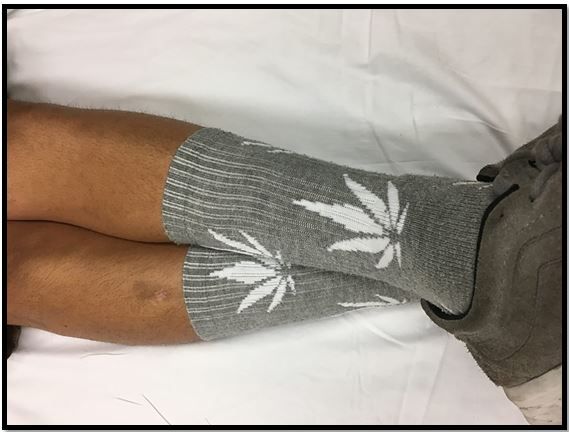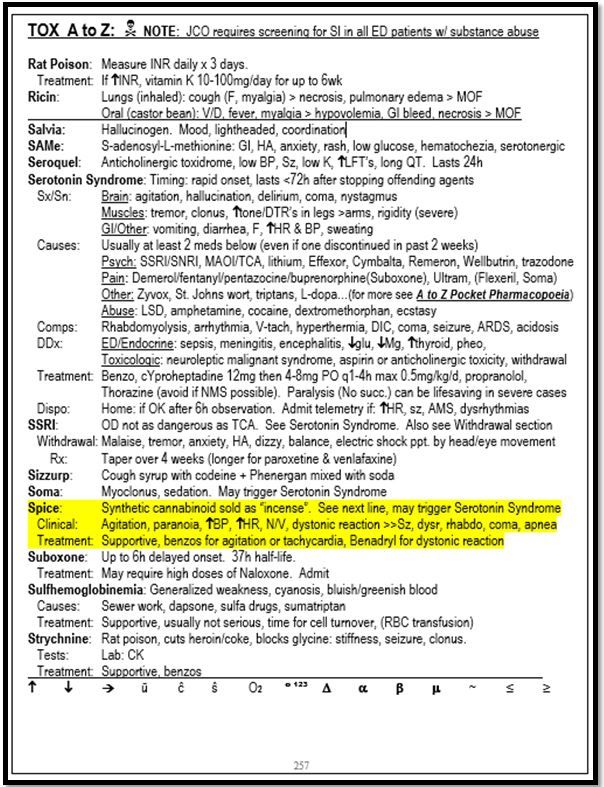The "Pot Socks" Sign
Sudden onset of difficulty breathing, dry mouth, and stiff, swollen neck and throat. . . what diagnostic clue do the patient's socks offer, and what action should follow?

Figure (please click to enlarge)

History: A 15-year-old male who has been having trouble breathing is brought to the ED by his mother. The patient states that about 30 minutes earlier, he felt like his mouth got really dry and his neck and throat started to feel stiff and swollen. He denies eating any new foods or taking new medications and says he has not used any illicit drugs.
He has no rash, fever, sore throat, chest pain, or other complaints.
The nurse has placed the patient in a critical room and asks you to see him right away for a possible airway emergency. You hightail it into the room.
Examination: You note that the vital signs taken at triage were normal except for a pulse rate of 118 bpm. His skin exam shows no hives or other rash. The head and neck exam is normal except for slight trismus; you note that his neck is in a sniffing position. There is no stridor or drooling. His lungs are clear, without wheezing or prolonged expiration and there is good air movement. His heart is tachycardic but regular. His abdomen is benign. Examination of his extremities reveals a negative Homan’s sign and no appreciable edema.
You notice one interesting exam “finding” while checking his legs (Image, top of page).
Initial Concerns:
• Epiglottitis
• Anaphylaxis
• Drug toxicity
Question:
1. What diagnostic clue do the socks offer and what action do they prompt?
Please click "next" for answers and discussion.Answer:
1. What diagnostic clue do the socks offer and what action do they prompt? The socks with the marijuana leaf design should prompt you to give IV diphenhydramine (Benadryl) for a possible dystonic reaction. When this patient’s mother was removed from the room, the patient confessed that he had been smoking Spice just before his symptoms started. Spice can cause a dystonic reaction.
Discussion
Spice, also sometimes known as K2, is a synthetic cannabinoid that can cause a variety of adverse reactions, even with normal use (see Figure, highlighted section). As with marijuana, there can be an agitated reaction characterized by some combination of anxiety, paranoia, hypertension, and tachycardia. Nausea and vomiting may also occur. Unlike marijuana, however, Spice can cause dystonic reactions, which most commonly manifest as tonic contraction of muscles in the neck and/or face. Less common but more serious adverse effects of Spice may include serotonin syndrome, seizure, cardiac dysrhythmias, coma, apnea and even death.
Testing and treatment are tailored to the patient presentation. Agitation or elevated vital signs and even seizures can usually be controlled with benzodiazepines. Dystonic reactions should respond to antihistamines such as diphenhydramine. Supportive care may also be required.
Case Outcome: The dystonic reaction resolved after diphenhydramine administration.
Resource: Spice/K2 toxicity from: The Emergency Medicine 1-Minute Consult Pocketbook